|
|
|
|
#1
|
||||
|
||||
|
I realize that there is currently a discussion about this, but I didn't want to highjack the thread.
I for one am a PSA guy. I have nothing against SGC, but being a post-war collector, I choose PSA because it is more readily available. When it comes to Pre-War cards I am indifferent. I would like to limit this discussion to the T206 set. It seems as though PSA demands a higher price for mid grade and high grade cards. I went through VCP and took the average price of all T206 cards (minus the big 4) per grading company. What I found wasn't too surprising. PSA and SGC have an immaterial difference in their average price for low grade cards (ie. "2" & "3"). We start to see a difference at a "4" (With PSA at $132.66 compared to SGC at $124.48). NOTE: These prices include stars and Hall of Famers. This isn't a huge gap, but when we reach "5" the difference grows to $30 per card and at "6" the difference is over $60. See chart below: 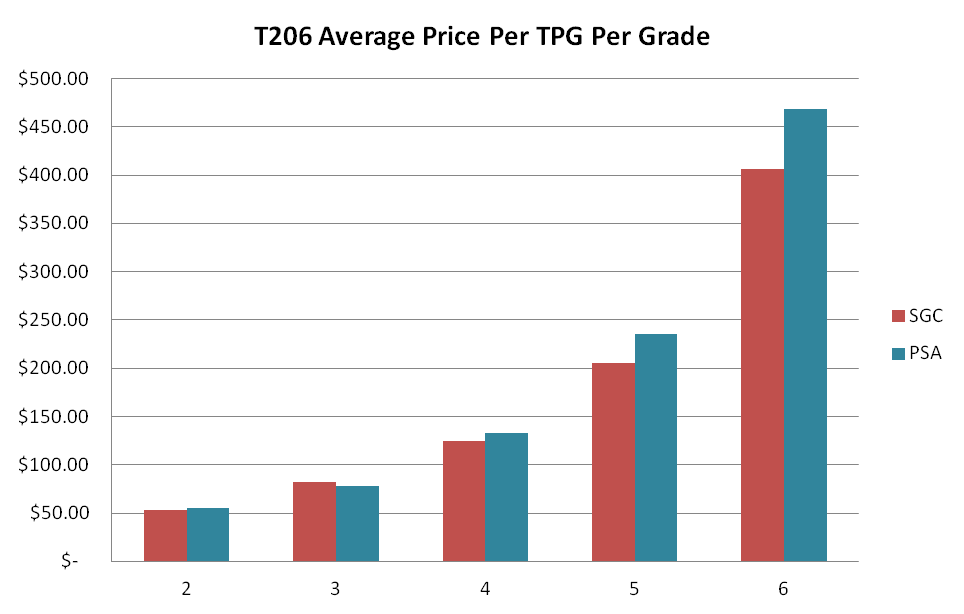 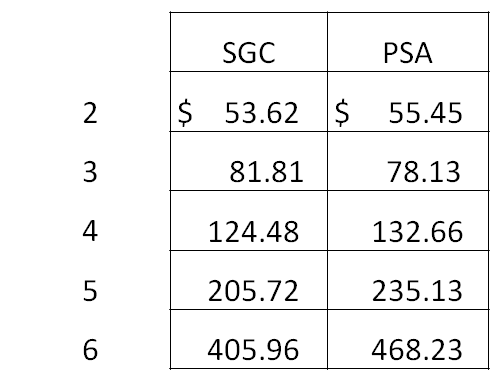 What explains this difference? At first I thought it was demand. Perhaps a higher concentration of mid grade SGC cards dilute their value. So, I then turned to the population reports of both companies. I was somewhat surprised at what I found. There are FAR more mid grade PSA T206 cards than SGC. Almost 25,000 more 4's, 15,000 more 5's, SIX times as many 6's and 5 times as many 7's. This anomaly is not explained by shear volume. A breakdown of the percentages show that PSA assigns a "4" to 27.28% of their cards while SGC is at a meager 18.06%, and SGC assigns a large amount of 1's and 2's. NOTE: For this analysis half grades were rounded down and qualifiers were given a 2 point deduction. 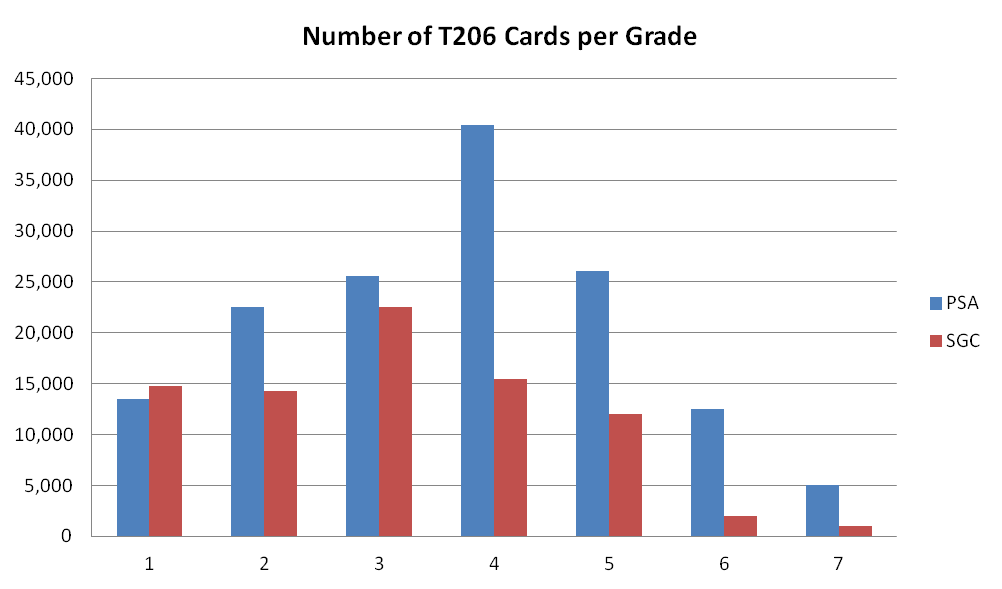 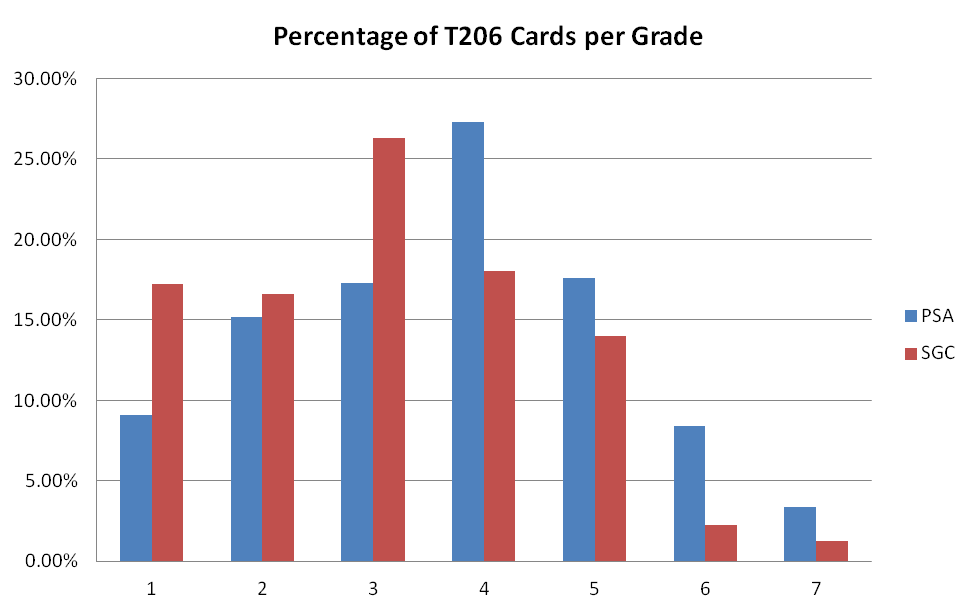 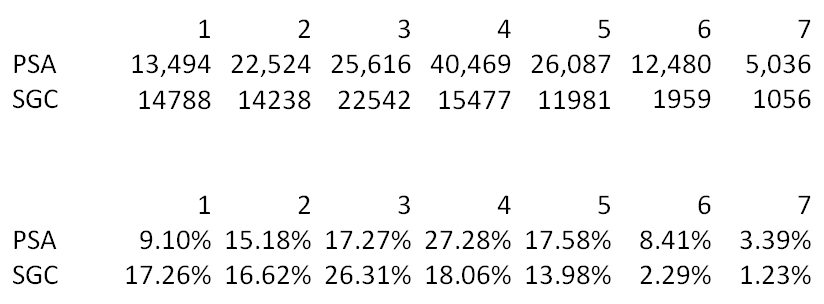 It seems as though mid grade T206 cards defy the most basic law of economics, supply and demand. There is a far greater supply of mid grade PSA cards as opposed to SGC, so why the difference in price? Well, SGC and PSA cater to two separate consumers. SGC, the collector; PSA, the investor. Most here can agree that SGC displays a card better than PSA. For a collector with no intention of selling their collection and only assigns a value based on a personal level, SGC is a far greater company to send your cards. To the collector who plans to sell their collection, PSA is the way to go. Neither one can fully understand the other and while I would label myself as an "investor" I have nothing but the utmost respect for collectors of SGC cards. I have a completed PSA registry set (not T206), and I while I enjoyed the rush of collecting the cards, I must admit I began to focus more on the plastic than the cardboard. It seems as though the "collector" who is obsessed with a numeric grade leans towards PSA. I'm not saying collectors of SGC cards do not care about condition, but they focus more on the card than the flip. This trend can be seen throughout all sets, but it is most obvious in this example. Neither the collector or the investor are better in anyway, they're just different and in conclusion; PSA and SGC are two very different companies that share the same market. While on the surface they appear identical, to an experienced collector, they are not. In my opinion it is pointless to argue which company is "better" or "worse" because quite simply, they are designed for different types of collectors. On a completely separate note I thought this was interesting: The total cost of assembling a graded T206 set (minus the big four). 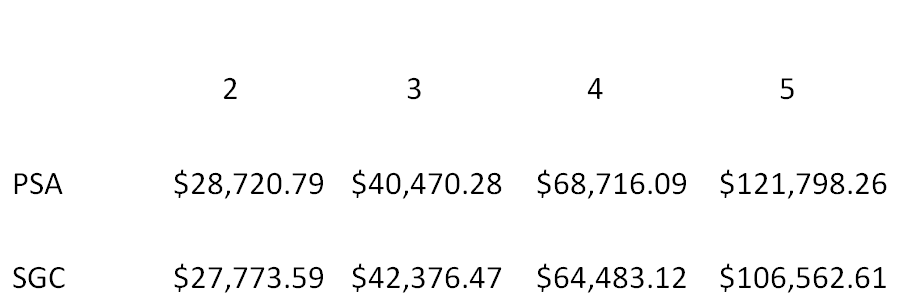
|
|
#2
|
||||
|
||||
|
Finally, some cold, hard facts! I was getting sick of people comparing all their anecdotal evidence. Looks like some solid work there.
Although I disagree that SGC slabs look better than PSA's. I like the minimalist, thin, transparent holders. I think they put more emphasis on the card rather than the case. But then again, that's all subjective 
|
|
#3
|
||||
|
||||
|
Wow, that is really cool.
Personally, I do not care about the grades, whatsoever. Not anymore. However, I absolutely love the black casing used by SGC. To me, it just looks cooler. I do hate, hate, hate the "unknown backs" in the PSA pop reports, but oh well... Really cool work in the OP. Thanks. Derek |
|
#4
|
|||
|
|||
|
Very interesting research. Thanks for sharing Jason. From all of the discussions on the board, I thought PSA was the best way to maximize your value for vintage cards (42-79) and SGC for pre-war.
Maybe the size of the holder plays a factor? I would imagine 500+ PSA cards take up significantly less room than 500+ SGC cards.
__________________
Mantle Master Set - as complete as it is going to get Yankees Game Used Hat Style Run (1923-2017): 57/60 (missing 2008/9 holiday hats & 2017 Players Weekend) |
|
#5
|
||||
|
||||
|
Great report. I do like the SGC holders. The cards present much nicer then PSA. However PSA does bring higher $$$
__________________
Ruben |
|
#6
|
||||
|
||||
|
Great work Jason with the stats.
I just wanted to say that there are many sales(private transactions) that don't get recorded on VCP. And then you have the crossovers that don't get recorded. So, there's probably a little wiggle room on there in either direction with population & prices realized. But I think you've given the most accurate breakdown that someone could possibly give- nice job !! I buy cards graded by both companies (well, all three including BVG) and I don't think much about resale value because I don't plan on selling any of mine until decades from now (knock on wood) and who knows where things will be then. I do know one thing- the cards will be that much older  . .Thanks for the breakdown, this was a cool read !! Sincerely, Clayton |
|
#7
|
|||
|
|||
|
PSA has more "supply", so more cards hit auction, more cards hit sales, more cards hit BIN's. If there wasn't a 1:2.67 ratio of PSA mid grade to SGC do you think they would demand more?
How many of these deviate higher or lower in price for each grade? The sheer volume difference IMO makes this simply an average of prices and not a reflection of the current market... Many more factors would need to be involved for a market value. The numbers being used can't be absolute because there is no way to know someone is going to pay exactly $23xxx or 64xxx for a set in whatever grade Last edited by Sean1125; 02-17-2013 at 06:06 AM. |
|
#8
|
||||
|
||||
|
Quote:
Funny i was thinking the same thing about SGC...I HATE how they don't differentiate the variations of a certain card....for instance, they don't differentiate the e90-1 variations of keeler, which there are 3.....this happens throughoutnthenentire set which make you extrapolate the true pop... |
|
#9
|
||||
|
||||
|
Very cool post. I would definately like to read a more researched article. If you are interested in writing one let me know.
|
|
#10
|
|||
|
|||
|
Quote:
Next, I disagree with your assertion that SGC caters only to collectors and PSA caters only to investors. No data has been provided that would even remotely support such a claim. Lastly- I agree with your comment about this defying the laws of supply and demand. What explains that outcome? People who begin the T206 set recognize and appreciate the higher availability of PSA cards in mid-grade, as they begin their set quest.The increased availability of mid grade T206, for that reason, has IMPROVED the cards value, not detracted from the value, as would be the case if we were talking about commodities. |
 |
| Thread Tools | |
| Display Modes | |
|
|